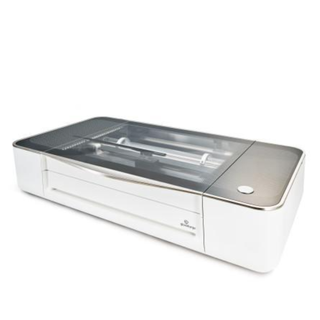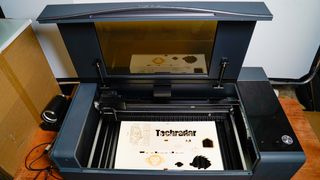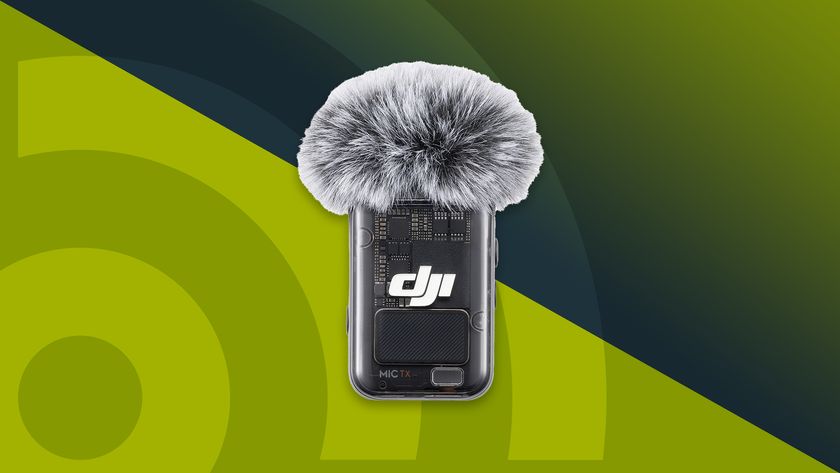Best laser engravers of 2025
We reviewed the best laser engravers for precision, speed, and performance

For precision, speed, and fine-detail, only the best laser engraver will make the cut. I tested out a range of laser engraving machines, and these are my top-rated recommendations for crafters, hobbyists, beginners, and professionals.
When it comes to modern crafting tools, laser engravers are becoming increasingly popular. Much like the best 3D printers I've reviewed, what once was the preserve of big business has made its way into studios, classrooms, small business premises, and even homes.
In my experience, the best laser engraver for most people is the xTool P2. This device stands out for its speed, accuracy, and overall performance - which exactly what I'm looking for when reviewing these units. Depending on your needs, I'd also recommend checking out the Glowforge Pro and Two Trees TS2, as well. Read my reviews below for my full thoughts and top picks for every budget and use-case.
The quick list

Best laser engraver overall
The xTool P2 shows a progression of the technology and is one of two CO2 laser engravers, but it just nudges ahead due to wide compatibility.

Best for classrooms
A maker favourite and for a good reason, the Glowforge is just about as refined as you get and a great solution, particularly in an educational environment.

Best for beginners
The quality of the build once assembled, makes this laser engraver stand out and packs in the safety features that cheaper models leave out.

Best for precision
The Creality Falcon2 is a high-precision laser engraver that stands out thanks to its cleverly designed tool head with integrated air assist that ensures a clean cut.

Best for accessories
The IKier K1 Ultra is a powerful choice for scaling your laser engraving set-up. It’s easy to assemble and calibrate, with a wealth of features and accessories for expanding its potential.

Best for upgrades
The Ortur LM3 is ideal for beginners and anyone looking for an affordable laser engraver and cutter that doesn’t compromise on quality. It even boasts wide software compatibility.
Best laser engraver overall
Why you can trust TechRadar

Specifications
Reasons to buy
Reasons to avoid
The xTool P2 laser engraver holds the crown as our best laser engraver, and for good reason. Uniquely positioned as one of the few fully enclosed engravers at its size and price point, this machine is not just a progressive evolution from open-framed alternatives; it's a quantum leap, designed to serve both serious enthusiasts and small businesses.
What elevates the xTool P2 to a class of its own are numerous standout features. From a user-centric computer-based software interface to a wide range of supported materials and an expansive collection of accessories, this machine has you covered for nearly any engraving or cutting project. The performance is unparalleled, delivering some of the cleanest cuts we've ever seen. Plus, it boasts invaluable add-ons like the RA2 Pro and a riser for handling larger objects.
However, it's not without imperfections. The machine's sizable dimensions and hefty weight demand teamwork for mobility, two people are needed just to shift it. Moreover, while the software is competent, it could benefit from the addition of bed image tracing, a feature offered by some competitors.
Yet, these are minor gripes in the grand scheme. The P2 offers an unmatched performance-to-price ratio. The robust build quality assures that this is more than a purchase; it's a long-term investment. If you're in the market for a versatile, durable, and high-performing laser engraver, the xTool P2 is an exceptional choice.
Read our full xTool P2 review
Best laser engraver for classrooms

Specifications
Reasons to buy
Reasons to avoid
Glowforge ticks boxes for businesses, schools, and craft enthusiasts. While it's easy to use and top-notch in quality, it does require a reliable Wi-Fi connection, and the Premium subscription isn't exactly pocket-friendly.
Unlike many self-assembly laser cutters, Glowforge is a ready-to-go workshop tool with a sleek design. It's a bit of a unit, so make sure you've got room, especially if you're adding the Air Filter—which, by the way, is a must-have for indoor use.
Temperature is another factor; this isn't a machine to stash in a cold garage. You'll also want to think about materials. Glowforge's own Proofgrade options are great but pricey, so I've often opted for more budget-friendly alternatives.
The Premium subscription is full of perks but might be a stretch for hobbyists, especially given the skimpy seven-day trial. Connectivity is Wi-Fi only, which might put some off, but it's a minor point.
In the classroom or the workshop, Glowforge consistently impresses, breezing through 3mm ply sheets like they're nothing. At home, you'll find its performance unbeatable for the price, even if you opt for the more affordable Glowforge Basic.
Read our full Glowforge Pro laser cutter review
Best laser engraver for beginners

Specifications
Reasons to buy
Reasons to avoid
The Two Trees TS2 Laser Engraver is a standout choice for hobbyists and small businesses alike, offering unmatched quality and performance that justifies its slightly higher price tag. However, it's not without its quirks. The initial setup can test your patience with fiddly screws and belts, especially in confined spaces—so perhaps consider moving the assembly to a spacious workshop.
Once built, you're rewarded with a robust and aesthetically pleasing machine, complete with anodised parts. Setting it up is generally straightforward, although those on iOS might find the Wi-Fi connectivity somewhat finicky. That said, the manual, while comprehensive, could be clearer on some of the nitty-gritty details. Performance-wise, the TS2 excels in both engraving and cutting tasks, offering excellent quality that sets it apart as a prime choice for serious enthusiasts.
Beyond its core capabilities, the machine is also expandable, allowing for additional attachments like an air pump for fume extraction. Still, it's worth noting that it lacks an enclosure, so make sure you have plenty of space and a well-ventilated area. The Wi-Fi connection can be troublesome on iOS devices, although it works beautifully on Android. Overall, if you're willing to overlook these minor drawbacks, the Two Trees TS2 offers professional-level laser engraving at a reasonable price and is one of the best laser engravers on the market.
Read our full Two Trees TS2 laser engraver review
Best laser engraver for precision

4. Creality Falcon2 40W
Specifications
Reasons to buy
Reasons to avoid
Fresh to the market, the Creality Falcon2 40W is one of a family of three new laser engravers from one of the leading manufacturers of 3D printers. The Falcon2 arrives as an update to the original Falcon and is available in three different power options: a robust 40W, a more standard 22W, and a lightweight 12W. Leveraging its recent innovations in 3D printing, Creality ensures that this machine's clean cuts and engravings set it apart.
Once assembled, the design quality of this open-framed laser engraver instantly stands out, thanks to its all-metal frame and innovative tool head with integrated air assist. This feature goes a long way in explaining why the cuts and engravings from this machine are so clean.
As we're increasingly seeing with these machines, the basic model is just the starting point. Creality has created a whole ecosystem of accessories to complement the use of the machine. These include a roller for cylindrical engraving, an extremely well-priced full enclosure—which is an absolute essential—and a good selection of materials. This machine is an ideal first step for both enthusiasts looking to invest and professionals entering the market.
Best laser engraver for accessories

5. IKier K1 Ultra 36W
Specifications
Reasons to buy
Reasons to avoid
A relative newcomer to the laser engraver market, this new machine elevates build quality and ecosystem to another level. That's hardly surprising, given that the company behind this new entrant is Atomstack, a name well-known for its innovations in both 3D printing and laser engraving. The IKier brand showcases their premium range of powerful laser engravers, featuring all-metal construction and a broad array of accessories.
As with nearly all the laser engravers in this buyer's guide, a certain level of assembly is required to get the IKier K1 Ultra 36W up and running. Fortunately, the instructions are straightforward, and so are the calibration and setup processes. What truly distinguishes this engraver is the wealth of features and accessories available to expand the machine's potential. While many of the best laser engravers have accessories available, we were really impressed with IKier K1 Ultra’s offerings.
One crucial accessory for any open-frame design is a reliable enclosure, and IKier offers a sound option at a reasonable price. Notably, among the myriad accessory choices is the IKier C1 LightBurn Camera, which enables precise positioning of materials for laser engraving. As the name suggests, it's fully compatible with the LightBurn software, significantly enhancing the overall laser engraving workflow and ease of use. This camera feature provides a material preview through the software, allowing for more accurate placement of your designs.
Best laser engraver for upgrades

6. Ortur Laser Master 3
Specifications
Reasons to buy
Reasons to avoid
The Ortur Laser Master 3 (LM3) is a versatile machine, brimming with features that will captivate both newcomers and those in search of an affordable yet high-quality laser engraver and cutter. The basic LM3 package comes with a 10W laser that's more than adequate for beginners and leaves you some budget to invest in quality materials. However, the machine's potential scales seamlessly as your passion for laser engraving blossoms.
Arriving in multiple boxes, the LM3 requires some time and patience to assemble. While the wiring and frame assembly can be a bit fiddly, the process offers an invaluable opportunity to become intimately familiar with the machine's inner workings. As you become more proficient with the Ortur LM3, this initial hands-on experience will empower you to upgrade from the 10W to the 20W laser with relative ease.
Once assembled, the machine performs impressively straight out of the box. However, its range of optional accessories widens the scope of applications, making it versatile enough to accommodate your growing skillset. It's a robust choice for anyone venturing into laser engraving and cutting. Moreover, it boasts excellent compatibility with existing software options, ensuring a seamless transition for those looking to expand their creative horizons.
Best laser engravers: FAQs
What is a laser engraver?
A laser engraver is a specialised machine that uses laser technology to etch or engrave designs onto a variety of materials, including wood, metal, acrylic, and glass. Unlike traditional engraving methods that rely on mechanical processes, laser engravers offer a high degree of precision and flexibility. You can go from engraving intricate artwork to cutting through materials like 8mm plywood with a simple change of settings. The laser's accuracy ensures that you get incredibly detailed results, whether you're etching a complex pattern or making precise cuts for a project.
Controlled through either standalone software or directly via apps, these engravers are remarkably user-friendly, although connectivity can sometimes be a sticking point. For instance, Wi-Fi setup might be easier on PC and Android devices compared to Mac and iOS.
With laser engravers, you aren't limited to just flat surfaces; some models offer the ability to engrave cylindrical objects like bottles or glasses, thanks to special attachments. Add-ons like air pumps can also be fitted to help extract fumes produced during the engraving process, making for a safer and cleaner working environment.
Whether you're a DIY enthusiast looking to personalise your creations or a small business owner requiring high-quality branding on your products, laser engraving offers an unparalleled level of design freedom. It's an investment that, despite being pricier than traditional methods, offers a broad range of applications and almost limitless creative potential.
What kind of materials does a laser engraver use?
A laser engraver offers a versatile range of options when it comes to materials, giving both hobbyists and professionals plenty of scope for creativity. Here's a quick rundown:
Woods: From hardwoods like oak and mahogany to softer woods like pine and cedar, most wooden materials are excellent candidates for laser engraving. Keep in mind that softer woods engrave more easily but may also burn quicker, so adjustments to laser settings are essential.
Metals: While not all laser engravers can handle metals, those equipped with high-power lasers can work with aluminium, stainless steel, and even some types of brass and copper. Do note that coated metals may require specialized settings or additional preparation.
Plastics: Acrylics are perhaps the most commonly engraved plastic materials, offering crisp, clean engraving results. However, it's crucial to avoid PVC plastics as they release toxic fumes when engraved.
Leather: Real leather and some synthetic leather types engrave well, offering unique texturing opportunities. Do keep in mind that laser engraving essentially burns the leather, so some colouration changes are to be expected.
Fabrics: From denim to polyester, most fabrics can be engraved, although the results may vary based on the material's thickness and composition.
Glass and Stone: Some laser engravers can etch on glass and stone, although these materials usually require special considerations regarding laser focus and speed to prevent cracking or chipping.
Paper and Cardboard: These materials are the easiest to work with but are also the most delicate. They're great for intricate designs but remember that the laser can easily burn through, so adjustments are often needed.
When choosing a laser engraver, it's crucial to think about the types of materials you'll be working with most often. Not all engravers can handle every material, so do some homework to ensure your chosen machine meets your needs.
Do laser engravers use a lot of electricity?
The electrical consumption of a laser engraver varies significantly based on its size, power rating, and usage frequency. Here's a general guide:
Small Desktop Models: Low-power units designed for hobbyists usually consume less electricity, comparable to a standard PC. These units often operate in the 30W to 50W range.
Mid-Range Models: These laser engravers, often seen in small-scale businesses, have power ratings between 60W to 100W. Their power consumption can be likened to that of a high-end gaming PC or a small household appliance like a microwave.
Industrial Models: High-power engravers used in commercial settings can go up to 150W or even higher. These machines have the electrical consumption similar to industrial machinery and are best operated with a dedicated power source to ensure optimal performance.
Additional Considerations: Cooling Systems: Some laser engravers come with built-in cooling systems, which also consume electricity. However, they're generally not huge power drains.
Duration of Use: Naturally, the longer you run the engraver, the more electricity it will use. Some professional setups may run for several hours at a time, thus accumulating a higher electrical bill.
Standby Mode: Some engravers continue to consume power even when not actively engraving, especially if they maintain a heated bed or keep internal systems running.
While they're not the most energy-efficient machines around, they're generally not exorbitant in their power needs unless you're running a high-powered unit continuously. If energy consumption is a significant concern for you, it would be wise to check the specific power ratings and operational costs associated with the models you're considering.
What is the most profitable thing to make with a laser engraver?
The profitability of laser-engraved items can vary greatly depending on your target market, but some popular categories stand out:
Personalised Items: One of the most lucrative avenues is personalisation. Custom-engraved phone cases, cutting boards, jewellery, and even pet tags can fetch a premium price because they offer a unique, personalised experience for the customer.
Home Décor: Laser-engraved signs, wall art, and custom furniture markings are increasingly popular. When executed with skill, these items can command high prices, particularly if you use high-quality materials.
Corporate and Promotional Items: Corporate gifts, like custom-engraved pens, keychains, and awards, offer high profitability because businesses often place large orders and are willing to pay a premium for quality work.
Craft Supplies: Laser-cut stencils, engraving templates, and specialised crafting tools are in demand among hobbyists and can be sold at a high markup.
Small-Scale Manufacturing: If you've got a keen eye for design, creating branded or original items for sale, like coasters or trinket boxes, can also be quite profitable. When sold in sets, these can add up quickly.
Art and Collectibles: Laser-engraved art pieces can be extremely profitable, especially limited editions or intricate designs that showcase the capabilities of both the machine and the artist.
Seasonal Items: Don't underestimate the power of seasonal or event-specific items. Custom baubles at Christmas or engraved champagne flutes for New Year's Eve can yield excellent profits if timed well.
Remember, the key to profitability isn't just the item itself but how you market it. High-quality craftsmanship, excellent marketing, and superb customer service can make almost any laser-engraved item profitable.
Is laser engraving worth investing in?
Deciding whether laser engraving is worth the investment largely depends on your intended usage and entrepreneurial spirit. For small business owners and freelancers, a laser engraver can open up new avenues for personalised products, from custom-engraved jewellery to branded merchandise. The machine can quickly pay for itself if you're generating consistent sales.
For hobbyists, the investment value may not be immediately monetary but lies in the ability to bring creative projects to life with intricate detailing that's hard to achieve otherwise. It's worth noting that laser engravers, like any piece of advanced tech, require an initial learning curve and ongoing maintenance. So, while the upfront cost might be significant, the potential for innovation, customisation, and profit could make it a rewarding venture for both professionals and enthusiastic amateurs.
How to choose the best laser engraver for you
Choosing the best laser engraver for your needs involves a few critical considerations. First, ask yourself what materials you'll primarily be working with. Different lasers have varying capabilities when it comes to engraving and cutting materials, from softwoods to metals.
Size is another factor. If you're focusing on small, intricate designs, a compact unit may suffice. However, for larger projects or commercial applications, a more extensive engraving area would be beneficial.
Resolution is vital for detail work. Higher resolution engravers will offer you finer details but usually come at a higher cost and may take longer to complete a project. On the flip side, lower resolution machines are faster and less expensive but compromise on intricate detailing.
Connectivity and software are crucial, too. While some engravers come with standalone software, others might require third-party programs for design and operation. Depending on your technical comfort level, consider how easy it is to connect the engraver to your devices. Some are plug-and-play with USB, while others might require a more complex Wi-Fi setup.
Also, think about add-ons and expandability. Some laser engravers offer slots for additional modules like air pumps for fume extraction or rotary attachments for engraving cylindrical objects. These can extend the functionality of your machine and might be worth the extra investment if you anticipate diverse projects.
Finally, don't ignore safety features. Since you're working with lasers, eye protection and fume extraction are essential. Some units offer enclosures and built-in safety measures, but these often come at a higher price point.
Take the time to weigh these factors carefully, keeping in mind both your immediate needs and future applications, to make the most informed decision.
How we test the best laser engravers
Our testing process begins with the initial assembly and set-up of each laser engraver. We scrutinise how straightforward or intricate this phase is and how long it takes for calibration, setting the groundwork for the expertise level required for operation.
Next, we evaluate connectivity options, investigating how effortlessly the laser engraver synchronises with various software platforms. This ensures that you won't get bogged down by cumbersome tech hitches.
Features and accessories come under the spotlight next. We dive into what each machine offers, from advanced engraving options to additional attachments like air pumps for fume extraction or specialized lenses for intricate details.
The heart of our testing lies in assessing the quality of both engraving and cutting. We examine depth, clarity, and uniformity in engravings and measure the speed and precision of cuts. This gives us a rounded view of the machine's capabilities.
Some laser engravers come equipped with additional features such as internal cameras. These get special attention, as they often add considerable value and functionality.
By the end of this extensive evaluation, we have a clear picture of how each laser engraver performs on multiple fronts—from ease of use and versatility to engraving and cutting prowess. This allows us to deliver balanced, in-depth reviews that cater to both amateur enthusiasts and professionals, helping you make an educated choice for your engraving ventures.
Are you a pro? Subscribe to our newsletter
Sign up to the TechRadar Pro newsletter to get all the top news, opinion, features and guidance your business needs to succeed!
























